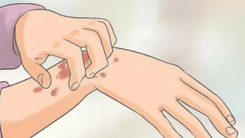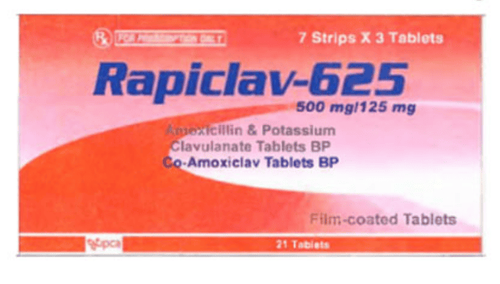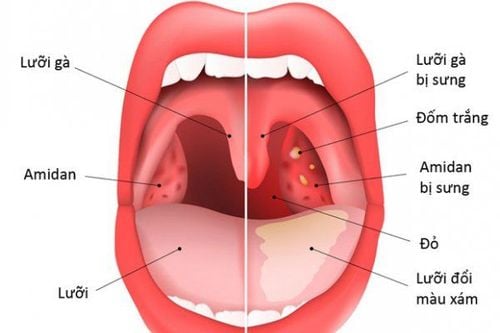The article is consulted by Dr.Tran Minh Tuan –Specialist I - ENT Specialist, Head and Neck Surgery – Department of General Surgery – Vinmec International General Hospital, Nha Trang.
Tonsillectomy (surgery to remove the tonsils) is a treatment for recurrent tonsillitis that affects your health. Thanks to advancements in medical technology, tonsillectomy has become increasingly simple and safe. However, some infection complications may still occur after the tonsillectomy. Therefore, if any unusual symptoms arise, you should visit a healthcare facility for an examination.
1. The tonsils are an important organ but are prone to inflammation
The tonsils are an organ that contains lymphocytes to protect the body against bacterial invasion. They are also responsible for producing IgG antibodies, which play a crucial role in immune function.
The tonsils are part of the immune system in the back of the mouth and top of the throat, and they are most active between the ages of 4 and 10. After puberty, the immune function of the tonsils significantly decreases, and they no longer function as vigorously.
When the tonsils work excessively to fight bacterial invasion in the nasal and throat areas, it leads to tonsillitis. The consequence of destroying bacteria in the tonsils often leaves behind debris, white blood cell remnants, and necrotic tissue, forming foul-smelling pus balls that may break off from the tonsils.
When the tonsils become inflamed repeatedly, their ability to fight bacteria weakens. The inflamed areas within the tonsils themselves become a source for recurring infections in the throat. Acute tonsillitis is primarily caused by viruses (about 70%).
Some common causes of tonsillitis include:
- Upper respiratory infections, colds, etc.
- Viral infections, such as the flu.
- Group A beta-hemolytic streptococcus, which causes tonsillitis and can lead to dangerous complications like acute arthritis, endocarditis (heart valve infection), valvular heart disease, and glomerulonephritis (kidney filter inflammation disease).
- Diphtheria bacteria, which cause inflammation with a pseudomembrane that blocks the airways and produces toxins.
- Fungal tonsillitis, which is commonly found in immunocompromised individuals.
When you have tonsillitis, you may experience the following symptoms:
- High fever above 39-40°C.
- Both tonsils are swollen and red, sometimes with a white pseudomembrane covering the tonsils.
- A dry throat, sore throat, and difficulty swallowing.
- Frequent headaches in the temples on both sides.
Nasal congestion, nasal discharge (initially clear mucus, which later becomes thicker and may be white or yellow...).
If tonsillitis is not treated promptly, it can recur multiple times and lead to complications such as peritonsillar abscess, scarlet fever, acute arthritis, glomerulonephritis, ...
Tonsillitis is usually treated with medical methods, including the use of antibiotics and anti-inflammatory drugs. However, there are also many cases where a tonsillectomy is required.
2. In which cases should a tonsillectomy be performed?
Not every case of tonsillitis requires a tonsillectomy. A child may have recurrent tonsillitis but still eat, sleep, and gain weight normally, without difficulty swallowing or breathing, and two tonsils are still functioning well. In such cases, tonsillectomy is not necessary.
Many parents bring their children to the hospital to request a tonsillectomy in such situations, believing that the tonsils are unnecessary and should be removed for the child to grow better. This belief is completely wrong. A large number of children with mild tonsillitis do not need to have their tonsils removed.
A tonsillectomy is only necessary in the following cases:
- Recurrent tonsillitis, occurring 5-6 times a year
- Tonsillitis causes complications such as abscess formation.
- Tonsillitis leading to complications like middle ear infections, sinusitis, or more severe issue such as rheumatic fever, glomerulonephritis, and arthritis
- Enlarged tonsils obstructing the airway, causing snoring or sleep apnea
- Repeated infections negatively affecting your quality of life
- In addition, tonsillectomy is necessary when the tonsils have many crevices that trap secretions, causing bad breath, difficulty swallowing, or suspected malignancy
Generally, children over the age of 5 can undergo a tonsillectomy if necessary. In some cases, children under 5 with significantly enlarged tonsils should also be considered for surgery. There are also many cases of individuals over 50 years old who still need a tonsillectomy.
3. Be cautious of infection complications after tonsillectomy:
Tonsillectomy is a simple, easy-to-perform, and generally safe surgery, but there can still be complications, including infections after the surgery, and in some rare cases, even death. The complications that can occur during or after a tonsillectomy include:
- Anaphylactic shock due to anesthesia: Before the tonsillectomy, the patient is anesthetized to relieve pain, and there is a risk of anaphylactic shock during the anesthesia process.
- Hemorrhage (bleeding): This is the most frequent complication following a tonsillectomy, with approximately 2-3% of patients experiencing postoperative bleeding. The mortality rate for this surgery is estimated at 1/40,000. Potential causes of hemorrhage include surgical technique errors, coagulopathies, or inadequate postoperative care. If you experience significant hemorrhage following a tonsillectomy that does not stop on its own, you should immediately go to the hospital for examination and prompt hemostatic treatment. Infection after tonsillectomy is not the primary or most urgent complication in cases of post-tonsillectomy hemorrhage.
- Infection after tonsillectomy: Localized infections after the surgery can cause fever.
- Sore throat and pharyngitis: Swelling and pain are common after a tonsillectomy, typically around the throat and ears.
- Weight loss: Due to lack of appetite and hydration caused by pain.
- Uvular edema and hematoma: This condition can obstruct the airway after surgery.
- Injury to the surrounding throat tissues or incomplete tonsil removal.
- Changes in voice
- Psychological trauma, anxiety, or depression.
- Death: Caused by complications from anesthesia or hemorrhage.

4. Tips to reduce the risk of infection complications after tonsillectomy
After a tonsillectomy, you can engage in light activities and should avoid strenuous activity for 2 weeks post-surgery. You can return to school or work once you're able to eat and drink comfortably and experience minimal pain. No post-operative complications such as high fever, difficulty breathing, or bleeding from the throat or mouth should be observed.
Almost all patients experience swelling and pain after a tonsillectomy. You will feel a sore throat upon waking, and this condition may persist and even worsen during the first few days. It may take 10-12 days for the pain to completely subside.
You can follow these steps to help reduce pain, promote recovery, and prevent infection complications after a tonsillectomy:
- Medications: Take pain relievers and anti-inflammatory medications as prescribed by your surgeon or hospital staff.
- Fluids: It is essential to drink plenty of fluids after the tonsillectomy to avoid dehydration. Fruit juices or smoothies are good options for you.
- Food: Soft, liquid foods that are easy to swallow, such as applesauce or broths, are the best choices immediately after surgery. You should gradually add easy-to-chew and swallow foods to your diet as soon as possible. Avoid acidic, spicy, hard, or crunchy foods, as they can irritate the surgical site, causing pain or bleeding.
- Rest: You need to rest in bed during the first few days after surgery, which is very important. Avoid strenuous activities like jogging or cycling for two weeks after surgery. You can return to school or work when you're able to eat and drink comfortably, experience minimal pain, and have no post-operative complications such as high fever, difficulty breathing, or bleeding from the throat or mouth.
If you experience signs of infection such as fever along with a sore throat or heavy bleeding, seek medical attention immediately at the hospital for prompt examination and treatment.
To arrange an appointment, please call … or make your reservation directly HERE. You may also download the MyVinmec app to schedule appointments faster and manage your reservations more conveniently.













